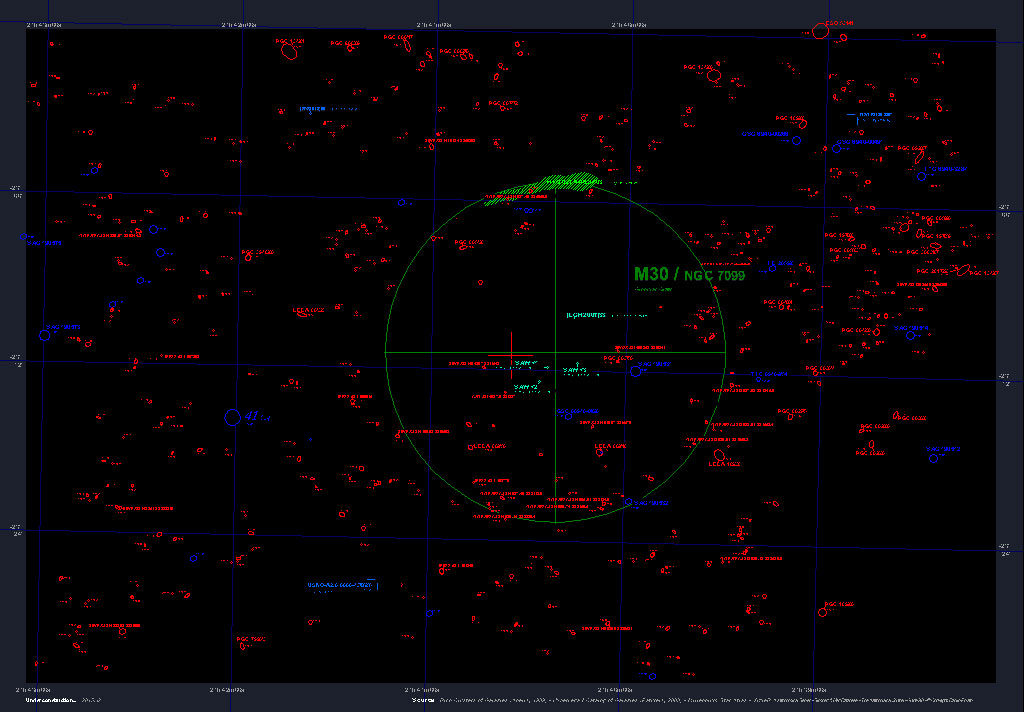 |
||
| Al di la della Luna; Beyond the Moon; Astrophotography; Astrofotografia; Danilo Pivato | ||
 |
|||
Photo: Danilo Pivato © Copyright: - Images & texts 2015 - All rights reserved |
|||
The Analysis of Frame |
|||
M30; NGC 7099; GCL 122; ESO 531-SC021; Bennett 128; h 2128; GC 4687; CD-23 17047; HD 206107: Globular Cluster - [field: 0,75° x 1,1°] |
|||
M30 Region: RAJ2000.0 21h40m22.12s - Dec J2000.0 -23°10'47.5" [SIMBAD] -
|
|||
Historical observations: William Herschel (c.1784): In the Philosophical Transactions, 1814, William Herschel described it as "a brilliant cluster, the stars of which are gradually more compressed in the middle. It is insulated, that is, none of the stars in the neighbourhood are likely to be connected with it. Its diameter is from 2' 40 to 3' 30 arcseconds. Its figure is irregularly round. The stars about the centre are so much compressed as to appear to run together. Towards the north, are two rows of bright stars 4 or 5 in a line. In this accumulation of stars, we plainly see the exertion of a central clustering power, which may reside in a central mass, or, what is more probable, in the compound energy of the stars about the centre. The lines of the bright stars, although by a drawing made at the time of observations, one of them seems to pass though the cluster, are probably not connected with it." In the Philosophical Transactions, 1818, William Herschel wrote: "1794, 7 feet finder, it is but just visible. 1794, 7 feet telescope. it seems to be resolvable, but is too faint to bear a high power. 1810, 10 feet telescope. with 71 power, it appears like a pretty large cometic nebula, very gradually much brighter in the middle. 1783, it appears like a pretty large cometic nebula, very gradually much brighter in the middle. 1783, with 250 power it is resolved into very small stars. 1783, small 20 feet Newtonian, 12 inch diameter, power 200, it consists of very small stars; with two rows of stars 4 or 5 in a line. 1783, large 29 feet Newtonian, power 120, by a drawing of the cluster, the rows of stars probably do not belong to the cluster. 1784, 1785, 1786, 20 feet telescope, power 157. A brilliant cluster. 1810, large 10 feet telescope, with 171 and 220 the diameter is 3' 5 seconds; it is not round." John Herschel (1847) Cape Observations: Observed by Sir John Herschel at the Cape of Good Hope with an 18-inch f/13 speculum telescope. He recorded it as "globular, B, lE, bM, 4' long, 3' broad; all resolved into stars 16m, besides a few 12m. Two lines of rather larger stars run out N.f." Webb, T.W. (1893): In the 5th edition of Webb's Celestial Objects for Common Telescopes it is described as "moderately bright; beautifully contrasted with an 8th mag star beside it; comet-like with 64x; with higher powers resolvable. Admiral Smythe (1884): 'What an immensity of space is indicated! Can such an arrangement be intended, as a bungling spouter of the hour insists, for a mere appendage to the speck of a world on which we dwell, to soften the darkness of its petty midnight? This is impeaching the intelligence of Infinite Wisdom and Power, in adapting such grand means to so disproportionate an end. No imagination can fill up the picture, of which the visual organs afford the dim outline; and he who confidently probes the Eternal Design cannot be many removes from lunacy.' Admiral Smythe called it a "fine, pale white cluster .. bright and from the straggling streams of stars on its north edge has an elliptical aspect with a central blaze; few other stars in the field." Messier, Charles: This globular cluster is Capricorn was discovered by Messier in August 1764. His small Gregorian reflector with an equivalent modern aperture of 2-inches could not resolve it into stars, showing him only a round nebula without stars: "nebula ... seen with difficulty in an ordinary telescope of 3.5 feet .. it is round and I saw no star there, having observed it with a good Gregorian telescope of 104x." Camille Flammarion: "Sotto al gruppo formato, nella coda del Capricorno, dalle stelle d, g, x ed e, si vede una stella fra le lucide della 6^, che porta il n. 41, all'ovest della quale un cannocchiale vi mostrerà un bell'ammasso (M30), scoperto da Messier nel 1764 e da questi registrato come una nebulosa, che poi venne risoluta in minutissime stelle da Guglielmo Herschel nel 1783. Questo lontano universo sembra isolato nel mezzo di un immenso deserto tenebroso, esempio non raro, ma qui tanto più naturale inquantochè questa regione è singolarmente povera di astri quanto ricca di lacune."
|
|||
